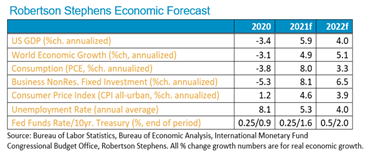As published in Wealthmanagement.com, by Chief Economist, Jeanette Garretty

December 31, 2021 – The US economy is likely to enter 2022 in full flood, following robust consumer spending during the holiday season and an outlook for attractive earnings growth for US companies. Globally, economic success has not been universal, and the difficulties presented in managing COVID continue to be disruptive; nevertheless, growth will be the dominant theme internationally as well, with a solid basis for anticipating 5% economic growth.
However, the real character of the economic outlook for 2022 may be better defined by the various obstacles that are likely to roil the waters of the economic expansion—an expansion that must still be seen as substantially influenced by the extraordinary events of 2020. Chief among these obstacles is the acceleration of inflation and the associated impact on monetary policy around the world. Major central banks, ranging from the Reserve Bank of Australia to the Bank of Canada to the People’s Bank of China, and, of course, including the US Federal Reserve and the ECB, have all signaled the need to re-evaluate or change monetary policy in 2022 as a result of the inflationary pressures which emerged in 2021. Yet, demands for full employment and strong economic growth remain high, and in areas where fiscal spending is not an adequate partner, central banks will be charged with sustaining economic activity. Interest rates can be expected to rise in the second half of 2022, if not before, and this change will test the navigation skills of all market participants.
Fiscal spending aimed at increasing economic growth and returning labor markets to full health after the ravages of the pandemic will be, perhaps counterintuitively, another challenge in 2022. In the United States, where two substantial spending packages are anticipated to take effect by the start of the year, the fiscal stimulus is being introduced into a tight labor market adjusting to the structural changes of an aging population, early retirements and mismatched skills and/or geographic locations. Wage growth has accelerated sharply, although not universally. In response, employers appear to be re-defining their business models and investing in productivity-enhancement throughout their operations. Companies can also be expected to re-innovate—but not abandon– their global supply chains, seeking to make globalization more secure and stable while continuing to offer the benefits of worldwide access to production and labor. Bottlenecks at ports, truck driver shortages, electricity grid failures, public health policies, etc. have heightened the risks and opportunities of the interconnected world in which we live and now beg for a response.
Finally, environmental issues will continue to loom as a large and increasingly important feature of economic growth in 2022. The navigational maps are only just being written, and the effort is expected to dominate much business and governmental activity across the year.
It is worth remembering that in every economic environment, there are both winners and losers, often distinguished primarily by the foresight, execution and essential luck of individuals and company management teams. Not everyone will find shooting the rapids of 2022 exhilarating, but those that do will be very well positioned for 2023 and beyond.
Jeanette Garretty is Chief Economist of Robertson Stephens, a wealth management firm striving to provide comprehensive and innovative investment solutions and wealth strategies to its clients through an intelligent digital platform. Investing entails risks, including possible loss of principal. Additional important information available at www.rscapital.com/disclosures.
